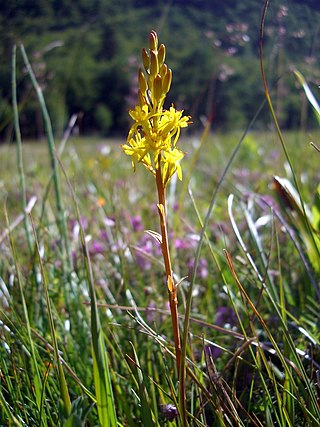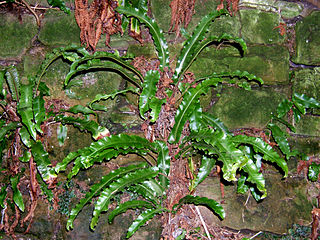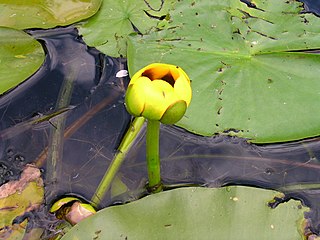
Ficus benjamina, commonly known as weeping fig, benjamin fig or ficus tree, and often sold in stores as just ficus, is a species of flowering plant in the family Moraceae, native to Asia and Australia. It is the official tree of Bangkok. The species is also naturalized in the West Indies and in the states of Florida and Arizona in the United States. It is one of the most common trees in Israeli cities and parks. In its native range, its small fruit are favored by some birds.

Saxifraga is the largest genus in the family Saxifragaceae, containing about 473 species of holarctic perennial plants, known as saxifrages or rockfoils. The Latin word saxifraga means literally "stone-breaker", from Latin saxum + frangere. It is usually thought to indicate a medicinal use for treatment of urinary calculi, rather than breaking rocks apart.

Saxifraga cernua, the drooping saxifrage, nodding saxifrage or bulblet saxifrage, is a flower common all over the High Arctic. It stretches further south in mountainous areas of the Alps, Norway, Iceland, Siberia and Alaska.

Chrysosplenium is a genus of flowering plants in the family Saxifragaceae. It includes 84 species found throughout the Arctic and northern temperate parts of the Northern Hemisphere. The highest species diversity in eastern Asia, and two species are found disjunctly in northern South America.

Narthecium is a Eurasian and North American genus of herbaceous flowering plants. This genus was traditionally treated as belonging to the family Liliaceae, but the APG II system of 2003 placed it in the family Nartheciaceae.

Asplenium scolopendrium, commonly known as the hart's-tongue fern, is an evergreen fern in the family Aspleniaceae native to the Northern Hemisphere.

Sparganium (bur-reed) is a genus of flowering plants, described as a genus by Linnaeus in 1753. It is widespread in wet areas in temperate regions of both the Northern and Southern Hemispheres. The plants are perennial marsh plants that can grow to 3.5 m, with epicene flowers.

Berberis thunbergii, the Japanese barberry, Thunberg's barberry, or red barberry, is a species of flowering plant in the barberry family Berberidaceae, native to Japan and eastern Asia, though widely naturalized in China and North America, where it has become a problematic invasive in many places, leading to declines in species diversity, increased tick habitat, and soil changes. Growing to 1 m tall by 2.5 m broad, it is a small deciduous shrub with green leaves turning red in the autumn, brilliant red fruits in autumn and pale yellow flowers in spring.
In enzymology, a 3-methylquercetin 7-O-methyltransferase is an enzyme that catalyzes the chemical reaction

Jepsonia malvifolia is an uncommon species of flowering plant in the saxifrage family known by the common name island jepsonia or island button-saxifrage. It is found only on the Channel Islands of California and Guadalupe Island off Baja California. It grows in exposed rock and clay soils on the chaparral and scrub slopes of the islands. This is a small perennial herb growing up to 10 inches tall. It produces two or three leaves from a flat caudex. The green leaves are round or kidney-shaped and edged with ruffled lobes. The plant flowers in fall, producing an inflorescence on a tall peduncle. The tiny flowers have red-veined white, yellowish, or pinkish petals. The fruit is a tan-striped greenish capsule. Its chromosome number is 2n=14.

Brewerimitella ovalis is a species of flowering plant in the saxifrage family known by the common names coastal miterwort and oval-leaf miterwort. It is native to western North America from southwestern British Columbia, including Vancouver Island, to northern California as far south as Marin County. It grows in moist, shady habitat, such as coastal forests and streambanks.

Hygrophila auriculata is a herbaceous, medicinal plant in the acanthus family that grows in marshy places and is native to tropical Asia and Africa. In India it is commonly known as kokilaksha or gokulakanta, in Sri Lanka as neeramulli. In Kerala and Tamil Nadu it is called vayalchulli (വയൽച്ചുളളി) and Neermulli (நீர்முள்ளி) respectively, and in the Telugu states, it is known as Godugu-gaddi (గొడుగుగడ్డి) or Gruddi-kamanchi (గ్రుడ్డికామంచి).

Chrysosplenium iowense is a species of flowering plant in the saxifrage family known by the common name Iowa golden-saxifrage. It is native to North America, where it is "primarily a Canadian species", occurring from the northern Northwest Territories south to British Columbia and east to Manitoba. There are also disjunct, relictual occurrences within the United States, in the Driftless Area of Minnesota and Iowa.

Chrysosplenium wrightii, or Wright's golden saxifrage, is a plant species native to northwestern North America and northeastern Asia. It grows on tundra and along stream banks at elevations up to 2300 m in British Columbia, Yukon, Alaska, the Kamchatka Peninsula in Russia, and in eastern Siberia. The plant was first described in 1878 as being from Japan. This was based on material collected along the Sea of Okhotsk presumably either Sakhalin Island or one of the Kuril Islands, parts of Japan at the time but now in the Russian Federation.

Penthorum sedoides, known by the common name ditch stonecrop, is a perennial forb native to the eastern United States and Canada which produces small white flowers in summer.

Chrysosplenium oppositifolium, the opposite-leaved golden-saxifrage, is a species of flowering plant in the family Saxifragaceae.
Nuphar ulvacea is a species of rhizomatous aquatic plant native to the US-American states Alabama and Florida.
Nuphar orbiculata is a species of rhizomatous aquatic plant native to the US-American states Alabama, Florida, and Georgia.

Nuphar × rubrodisca is a species of rhizomatous aquatic plant native to Canada and the USA. It is a natural hybrid of Nuphar variegata and Nuphar microphylla.


















